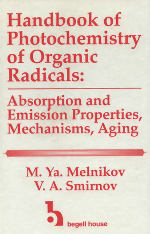| 1. ABSORPTION AND EMISSION PROPERTIES OF ORGANIC RADICALS AND BIRADICALS | 1 |
| 1.1. Introduction | 1 |
| 1.2. General Characterization of Luminescence from Polyatomic Molecular Systems | 1 |
| 1.2.1. Radiative transitions | 2 |
| 1.2.2. Processes of Radiationless Conversion | 4 |
| 1.3. Electronic Transitions and Absorption Spectra of Aliphatic Radicals | 5 |
| 1.3.1. Alkyl Radicals | 5 |
| 1.3.2. Allyl, Polyene, and Vinyl Radicals | 11 |
| 1.3.3. Alkoxyl Radicals | 15 |
| 1.3.4. Radicals of Alcohols and Ethers | 16 |
| 1.3.5. Acyl Radicals | 20 |
| 1.3.6. Radicals of Esters, Aldehydes, Ketones, Acids, and Anhydrous Acids | 22 |
| 1.3.7. Nitrogen-Containing Radicals | 25 |
| 1.3.8. Sulfur-Containing Radicals | 32 |
| 1.3.9. Peroxide Radicals | 39 |
| 1.3.10. Luminescence Parameters of Small Radicals | 45 |
| 1.4. Absorption and Emission Properties of Aromatic Radicals | 48 |
| 1.4.1. Benzyl Radical | 48 |
| 1.4.2. Benzyl-Type Radicals | 52 |
| 1.4.3. Hydroradicals | 64 |
| 1.4.4. Heteroradicals | 67 |
| 1.4.5. Radical ions | 70 |
| 1.4.6. Biradicals | 79 |
| 1.4.7. Stable Radicals | 89 |
| 2. ELEMENTARY PHOTOCHEMICAL PROCESSES | 92 |
| 2.1. Photodissociation | 92 |
| 2.1.1. Dissociation in Continuum | 92 |
| 2.1.2. Quasi-Equilibrium Dissociation | 93 |
| 2.1.3. Nonadiabatic Dissociation | 94 |
| 2.1.4. Predissociation | 94 |
| 2.1.5. Isotope Effect | 96 |
| 2.2. Photoinduced Intramolecular Electron Transfer | 97 |
| 2.2.1. Charge-Transfer Complex in Ground State | 100 |
| 2.2.2. Exciplexes | 104 |
| 2.2.3. Photoionization of Radicals | 110 |
| 2.2.4. Photoreduction of Radical Cations | 120 |
| 2.3. Photorearrangement | 121 |
| 2.3.1. Conformational Isomerism | 122 |
| 2.3.2. Configurational (cis-trans) Isomerism | 123 |
| 2.3.3. Structural (Valence) Isomerism | 124 |
| 2.4. Photoaddition | 126 |
| 2.5. Transfer of Electronic Energy | 127 |
| 2.6. Intennolecular Quenching in Exchange Complex | 130 |
| 3. PHOTOCHEMISTRY OF ALIPHATIC RADICALS | 132 |
| 3.1. Alkyl Radicals | 132 |
| 3.2. Allyl, Polyene, and Vinyl Radicals | 137 |
| 3.3. Alkoxy Radicals | 139 |
| 3.4. Alcohol and Ester Radicals | 139 |
| 3.S. Acyl Radicals | 144 |
| 3.6. Radicals of Esters, Aldehydes, Ketones, Acids, and Acidic Anhydrides | 145 |
| 3.7. Nitrogen-Containing Radicals | 150 |
| 3.8. Sulfur-Containing Radicals | 155 |
| 3.9. Peroxide Radicals | 161 |
| 4. PHOTOCHEMISTRY OF AROMATIC RADICALS | 169 |
| 4.1. Benzyl-Type Radicals | 169 |
| 4.2. Hydroradicals | 171 |
| 4.3. Heteroradicals | 173 |
| 4.3.1. Phenoxy radicals | 173 |
| 4.3.2. Aminyl radicals | 181 |
| 4.3.3. Stable nitroxyl radicals | 181 |
| 4.4. Biradicals | 182 |
| 4.4.1. Carbenes | 182 |
| 4.4.2. Nitrenes | 184 |
| 4.4.3. Miscellaneous biradicals | 186 |
| 4.5. Radical Ions | 188 |
| 4.6. Quenching of Excited Species | 201 |
| 4.6.1. Quenching of singlet states | 202 |
| 4.6.2. Quenching of triplet states | 205 |
| 4.6.3. Quenching of excited radicals. | 208 |
| 4.6.4. Quenching of the triplet-triplet fluorescence of carbenes | 212 |
| 4.7. Conclusion | 213 |
| 5. QUANTUM YIELDS OF ORGANIC RADICALS IN SOLID PHASE | 216 |
| 6. PHOTORADICAL CHAIN REACTIONS | 230 |
| 7. PHOTORADICAL AGING OF POLYMERS | 244 |
| 7.1. Introduction | 244 |
| 7.2. Pbotoradical Aging of Some Carbo- and Heterochain Polymers | 246 |
| 7.2.1. Polyolefins | 246 |
| 7.2.2. Polystyrene | 254 |
| 7.2.3. Fluorine- and chlorine-containing polymers | 259 |
| 7.2.4. Polyacrylates | 262 |
| 7.2.5. Poly(vinyl acetate), poly(vinyl alcohol), and poly(vinyl acetals) | 270 |
| 7.2.6. Poly(acrylic acid) and poly(acryl amide) | 281 |
| 7.2.7. Polyoxides | 284 |
| 7.2.8. Polyamides and aliphatic polyurethanes | 286 |
| 7.3. Special Features of the Kinetics of Photoradical Reactions in Polymers | 292 |
| 7.4. Means of Controlling the Efficiency and Pathway of Photoradical Reactions in Polymers | 295 |
| REFERENCES | 302 |

